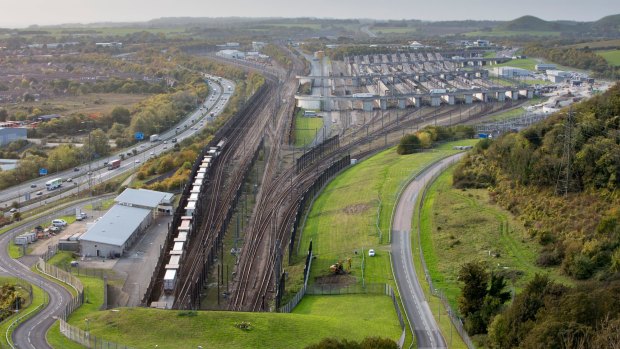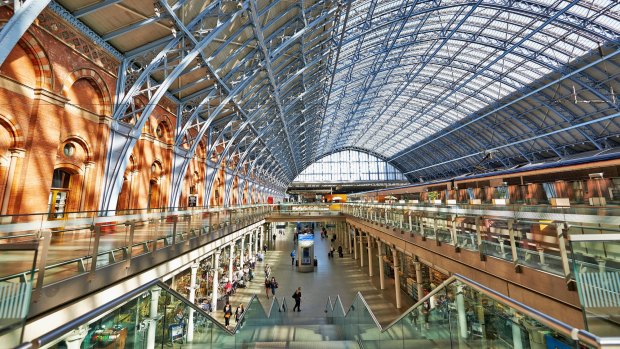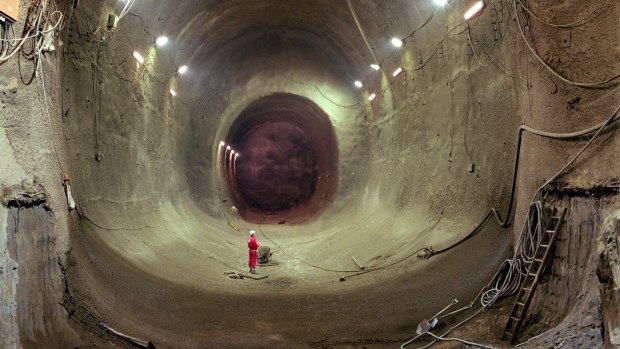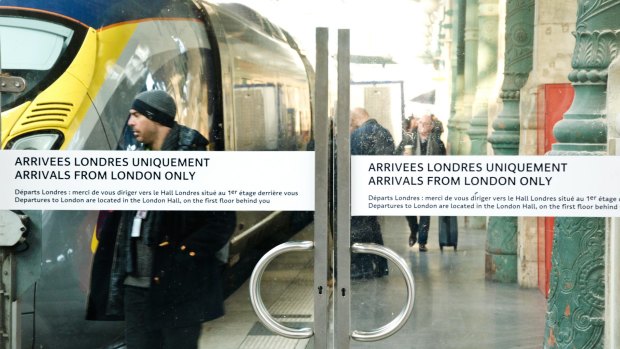This was published 4 years ago
Channel Tunnel's 25 anniversary: Engineering marvel keeps UK connected to Europe
By Keith Austin

The entrance to the Channel Tunnel in Cheriton, Kent.Credit: Getty Images
When the Channel Tunnel opened to passengers on November 14, 1994 (lorry and freight services began in May that year), it was the culmination of a dream started 192 years earlier.
Bear in mind that 1802 was the year the Seventh Earl of Elgin removed those "marbles" from Greece, Ludwig van Beethoven published his Moonlight Sonata and the Treaty of Amiens ending the French Revolutionary Wars was signed.
That treaty ushered in a fragile peace that lasted just over a year (when the Napoleonic Wars started) but it was enough for a French mining engineer to suggest to Napoleon Bonaparte that digging a tunnel under La Manche to L'Angleterre was an idea worth entertaining.

St Pancras Station in London - the main rail terminal for Eurostar train departures.Credit: iStock
Given that the French and les rosbifs had been at war since pretty much forever it would have taken much couilles to suggest this, but Albert Mathieu-Favier did just that.
Mathieu-Favier must have, at some point before 1802, looked at the 35-kilometre stretch of water between France and its seemingly eternal enemy and thought "what this needs is a tunnel". Which, given the technology and the politics of the day, was a big call.
He proposed a two-tier tunnel (a roadway and a small lower level for groundwater) lit by oil lamps, punctuated by tall ventilation chimneys that would poke up through the seas above, and traversed by horse-drawn carriages. Black-and-white drawings of the scheme still exist and show an artificial island built on a sandbank mid-channel where the horses could be changed and where, presumably, you stretch your legs and get a warm beer and a bowl of jellied eels.

Construction of the Channel Tunnel.Credit: Getty Images
There's a suggestion that Napoleon liked the idea but given the wariness and paranoia on both sides it's no wonder nothing became of Mathieu-Favier's prophetic notion.
The cat was out of the bag, though, and in the ensuing years it was an idea much discussed by such luminaries as the other Napoleons, William Gladstone, British prime minister David Lloyd George and Winston Churchill.
Work did start in 1881, when exploratory tunnels were dug on both sides of the Channel. The English shaft, just 2.1 metres in diameter, extended 1893 metres out from Shakespeare Cliff while the French dug 1669 metres out from Sangatte on the French coast not far from where the tunnel emerges today.

Passengers alight from a Eurostar high-speed train at Gare du Nord train station in Paris.Credit: iStock
Both were abandoned in 1882 amid fears that they could compromise national defences (900 years of near-perpetual war being seemingly difficult to put aside).
It was, however, an idea that was never going to go away and work finally began in earnest in 1988 after many post-World War II years of political and economic to-and-fro between Britain and France, including the 1975 abandonment of the project by the British Labour party due to costs and uncertainty about EEC membership.
It was British Prime Minister Margaret Thatcher who, along with French President Francois Mitterrand, announced in January 1986 that the tunnel would go ahead as a private, rather than public initiative.
Thatcher's preference was for a road tunnel because cars fitted her ideas of individualism and personal freedom. She was eventually persuaded to agree to a train tunnel due to safety concerns and the fact that trains wouldn't need a sophisticated ventilation system for exhaust fumes.
The contract to build the tunnel was won by the France-L Manche-Channel Tunnel Group with its proposal for two underground rail tunnels and a service tunnel. Total investment, at 1985 prices, was to be £2.6 billion. By 1994, the tunnel came in at £4.65 billion (naturellement) and Britain was an island nation no more. The link between it and mainland Europe which had been submerged by rising oceans 8000 years ago, had been breached by a link that was immediately hailed as one of the seven wonders of the modern world.
At 50.45 kilometres long, the tunnel links Folkstone in Kent to Coquelles in northern France and is the third-longest rail tunnel in the world behind the Gotthard Base Tunnel in Switzerland and the Seikan Tunnel in Japan. At its lowest point, it's 75 metres below the seabed and 115 metres below sea level. Some 37.9 kilometres of it are under water - the longest underwater section of any tunnel in the world.
It was officially opened by Queen Elizabeth II and Francois Mitterrand in a ceremony held in both Calais and Folkestone on May 6, 1994, during which the Queen praised "la combinaison de l'élan Français et du pragmatisme Britannique" – an idea wonderfully encapsulated in the fact that during construction the British gave their gigantic boring machines alphanumeric nomenclatures while the French sexed theirs up by naming them, ooh la la, after women.
Today, about 4.5 million UK tourists use the Channel Tunnel every year. And thanks to high-speed rail links that opened on the British side in 2003 and 2007 you can now travel from St Pancras in London to the Gare du Nord in Paris in just over two hours.
What the future holds, post-Brexit, is anybody's guess but a new, twice-daily direct route to Amsterdam, taking about four hours, was so popular last year that a third daily departure had to be added.
Rail Europe, Eurostar's largest distributor, says in the year to date, their Eurostar revenue is up 6.4 per cent and passengers up 8.1 per cent. The average year-on-year increase in passengers, it says, is 10 per cent.
Eurostar says the London-Paris route emits 90 per cent less greenhouse gas emissions than the equivalent flight – and in today's sustainable and environmentally conscious world, even Greta might get on board with that.
For details of Eurostar and other train journeys in Europe, see raileurope.com.au
NOTHING BORING ABOUT THE TUNNEL
- When the tunnel opened in 1994 the American Society of Civil Engineers voted it one of the seven Modern Wonders of the World alongside the Golden Gate Bridge, the Panama Canal and the Empire State Building.
- At the height of construction 15,000 people were employed on the project. Ten workers, eight of them British, were killed during construction.
- The two ends of the service tunnel joined up on October 30, 1990, when a 50-mm diameter pilot hole was opened. Presumably someone poked a finger through – how could you not? A more media-friendly event on December 1 that year saw tunnel workers Englishman Graham Fagg and Frenchman Phillippe Cozette break through the service tunnel with the press watching on.
- Graham Fagg, now retired, has since outed himself as a Brexiteer.
- The first Eurostar freight train ran on June 1, 1994, carrying Rover and Mini cars to Italy.
- The speed limit in the tunnel is 160 kilometres per hour.
- On the first day of official business (May 19, 1994) the "Chunnel'' carried 16 HGV lorry shuttles. In its first full year of operation (1995) Eurostar carried 3 million passengers.
- In 2017 the Eurostar service carried 10.3 million passengers and 1.22m tonnes of freight, and the Shuttle carried 10.4 million passengers, 2.6 million cars, 51,000 coaches and 1.6 million lorries.
- On the UK side, 5 million cubic metres of soil were extracted and most of it dumped at Lower Shakespeare Cliff, behind a seawall, to create the 74-acre Samphire Hoe Country Park.
- In 2009, former F1 racing champion John Surtees drove an electric sports car from England to France using the service tunnel but had to keep to the tunnel's 50k/ph speed limit. Not so British cyclist Chris Froome in 2014, who reached speeds of 64kph in the same tunnel to celebrate the Tour de France's transfer from its opening stages in Britain to France.
See also: Why the Ghan is one of the world's greatest trains
See also: Inside the world's longest, deepest passenger tunnel
Sign up for the Traveller Deals newsletter
Get exclusive travel deals delivered straight to your inbox. Sign up now.